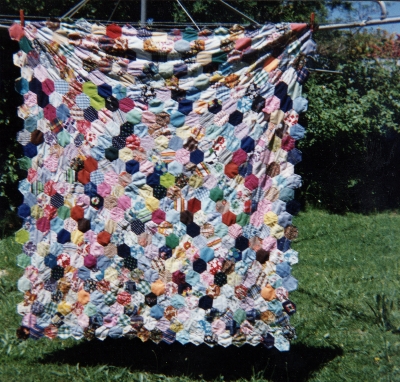Quilt No.347AL - Alice Lemon
No padding.
1551 x 1373mm
Made around 1958 by Vera Ellison, at the Wombat (NSW) Church Hall at meetings of the Anglican Church Women's Union. Owned by Alice Lemon.
"The maker (Mrs Vera Ellison) was a true country woman rearing a large family & joined our Church group about 1956-58. I used to pick her up & take her to meetings. All our members took materials to make 'dilly bags' for missions. Any scraps too small were cut into shapes to make the quilt all hand stitched except the end pieces.
I lived in the country until five years ago and it was during these years that Mrs Vera Ellison was a neighbour (a country neighbour can be miles away). I would pick her up & take her to our meetings & Church. She was a gentle person & a great Sewer & cook. Each member would bring scraps of a frock they had made & each shape stitched together would remind Vera herself and other members of each other.
� The Wombat C.W.U. is no longer as most members have left the district or passed on to a higher life."
[Letter from Alice Lemon 1997]
Related Quilts:
2200 x 1500mm
The quilt is of three layers because the strips of the log cabin are attached to a backing piece, and then the quilt is lined; however it is not padded." [NGA]
1931 x 1728mm
2400 x 2100mm
1770 x 1380mm








